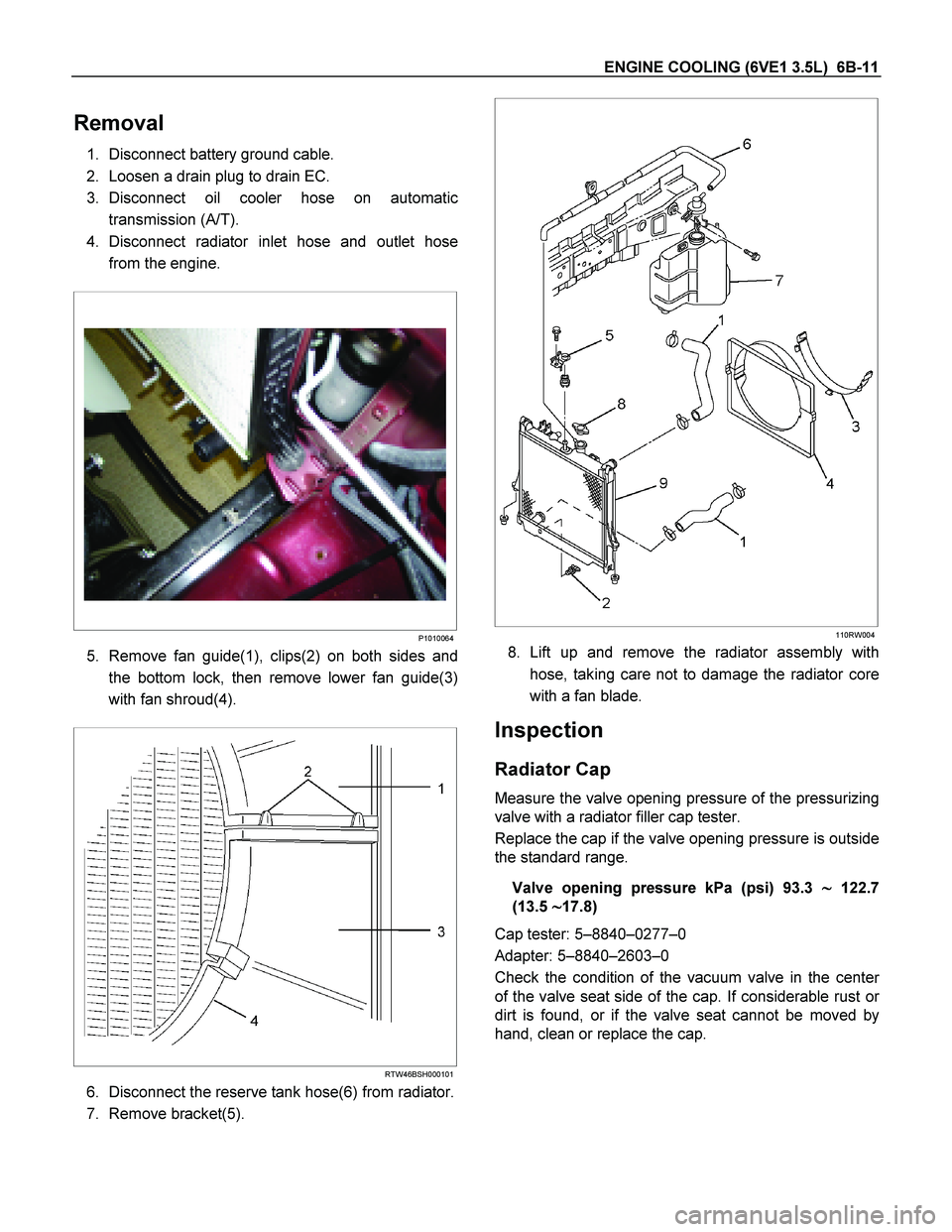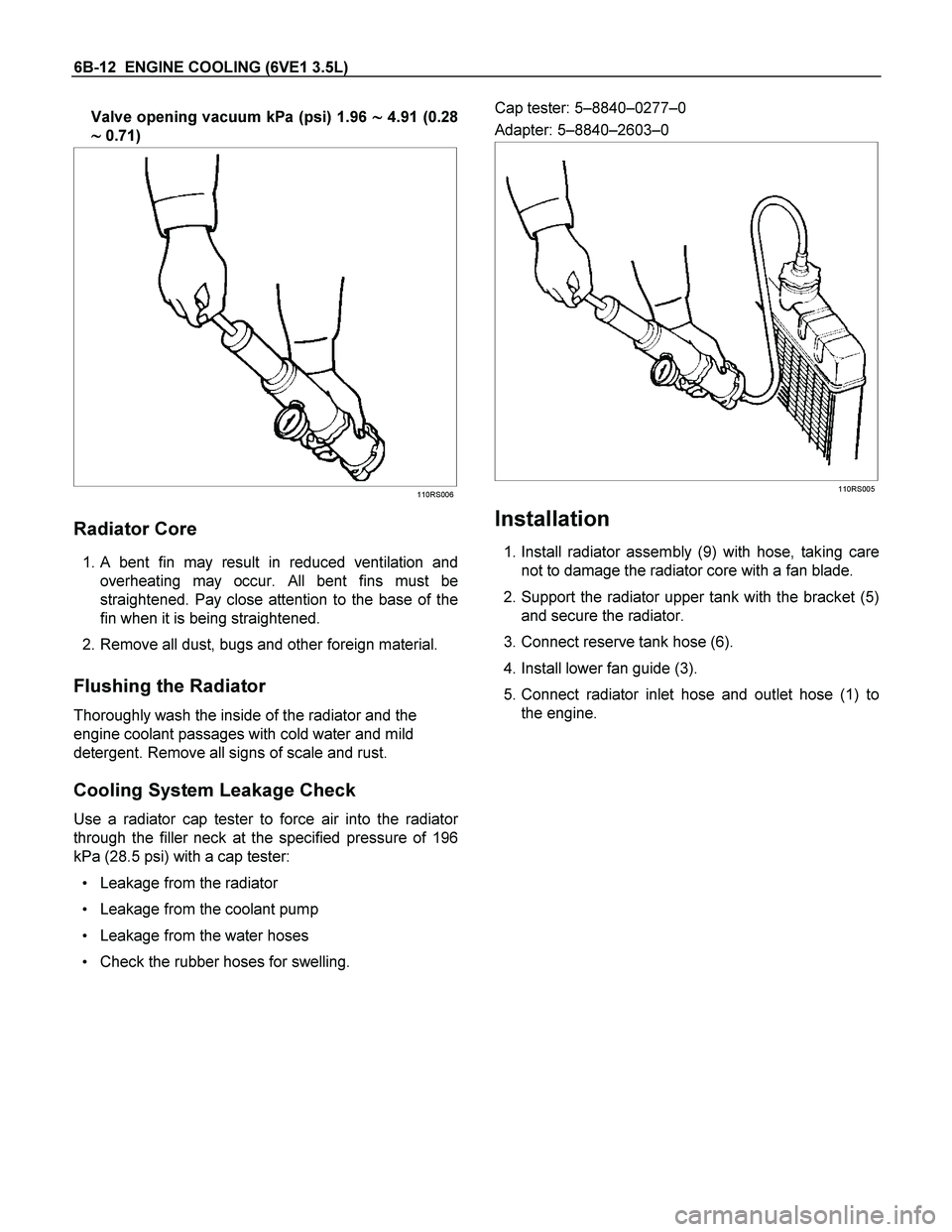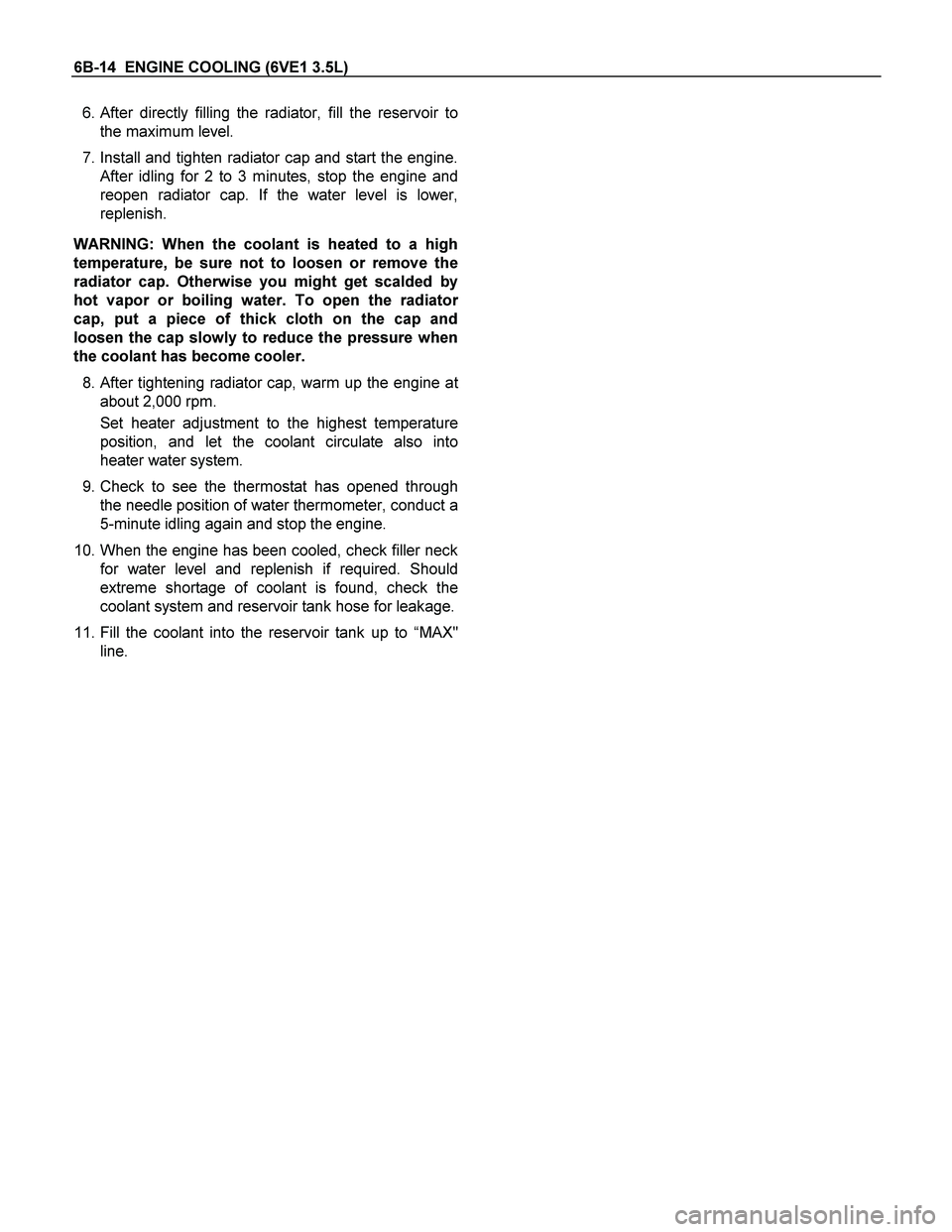Page 1934 of 4264
6B-10 ENGINE COOLING (6VE1 3.5L)
Radiator
Radiator and Associated Parts
RTW36BLF000101
Legend (5) Bracket
(1) Radiator Hose (6) Reserve Tank Hose
(2) Drain Plug (7) Reserve Tank
(3) Fan Guide, Lower (8) Radiator Cap
(4) Fan Guide (9) Radiator Assembly
Page 1935 of 4264

ENGINE COOLING (6VE1 3.5L) 6B-11
Removal
1. Disconnect battery ground cable.
2. Loosen a drain plug to drain EC.
3. Disconnect oil cooler hose on automatic transmission (A/T).
4. Disconnect radiator inlet hose and outlet hose from the engine.
P1010064
5. Remove fan guide(1), clips(2) on both sides and
the bottom lock, then remove lower fan guide(3)
with fan shroud(4).
RTW46BSH000101
6. Disconnect the reserve tank hose(6) from radiator.
7. Remove bracket(5).
110RW004
8. Lift up and remove the radiator assembly with
hose, taking care not to damage the radiator core
with a fan blade.
Inspection
Radiator Cap
Measure the valve opening pressure of the pressurizing
valve with a radiator filler cap tester.
Replace the cap if the valve opening pressure is outside
the standard range.
Valve opening pressure kPa (psi) 93.3
�
� �
�122.7
(13.5
�
� �
�17.8)
Cap tester: 5 –8840 –0277 –0
Adapter: 5 –8840 –2603 –0
Check the condition of the vacuum valve in the cente
r
of the valve seat side of the cap. If considerable rust or
dirt is found, or if the valve seat cannot be moved by
hand, clean or replace the cap.
Page 1936 of 4264

6B-12 ENGINE COOLING (6VE1 3.5L)
Valve opening vacuum kPa (psi) 1.96 �
�� � 4.91 (0.28
�
�� � 0.71)
110RS006
Radiator Core
1. A bent fin may result in reduced ventilation and
overheating may occur. All bent fins must be
straightened. Pay close attention to the base of the
fin when it is being straightened.
2. Remove all dust, bugs and other foreign material.
Flushing the Radiator
Thoroughly wash the inside of the radiator and the
engine coolant passages with cold water and mild
detergent. Remove all signs of scale and rust.
Cooling System Leakage Check
Use a radiator cap tester to force air into the radiator
through the filler neck at the specified pressure of 196
kPa (28.5 psi) with a cap tester:
Leakage from the radiator
Leakage from the coolant pump
Leakage from the water hoses
Check the rubber hoses for swelling.
Cap tester: 5–8840–0277–0
Adapter: 5–8840–2603–0
110RS005
Installation
1. Install radiator assembly (9) with hose, taking care
not to damage the radiator core with a fan blade.
2. Support the radiator upper tank with the bracket (5)
and secure the radiator.
3. Connect reserve tank hose (6).
4. Install lower fan guide (3).
5. Connect radiator inlet hose and outlet hose (1) to
the engine.
Page 1937 of 4264

ENGINE COOLING (6VE1 3.5L) 6B-13
6. Connect oil cooler hose to automatic transmission.
RTW36BSH000101
7. Connect battery ground cable.
8. Pour engine coolant up to filler neck of radiator, and
up to MAX mark of reserve tank.
RTW36BSH000101
Important operation (in case of 100% engine
coolant change) procedure for filling with engine
coolant.
Engine coolant change
1. To change engine coolant, make sure that the
engine is cool.
WARNING: When the coolant is heated to a high
temperature, be sure not to loosen or remove the
radiator cap. Otherwise you might get scalded by
hot vapor or boiling water. To open the radiato
r
cap, put a piece of thick cloth on the cap and
loosen the cap slowly to reduce the pressure when
the coolant has become cooler.
2. Open radiator cap and drain the cooling system by
loosening the drain valve on the radiator and on the
cylinder body.
NOTE: For best result it is suggested that the engine
cooling system be flushed at least once a year. It is
advisable to flash the interior of the cooling system
including the radiator before using anti-freeze
(ethylene-glycol based).
Replace damaged rubber hoses as the engine
anti-freeze coolant is liable to leak out even mino
r
cracks.
Isuzu recommends to use Isuzu genuine anti-freeze
(ethylen-glycol based) or equivalent, for the cooling
system and not add any inhibitors or additives.
CAUTION: A failure to correctly fill the engine
cooling system in changing or topping up coolant
may sometimes cause the coolant to overflow from
the filler neck even before the engine and radiato
r
are completely full.
If the engine runs under this condition, shortage o
f
coolant may possibly result in engine overheating.
To avoid such trouble, the following precautions
should be taken in filling the system.
3. To refill engine coolant, pour coolant up to filler neck
using a filling hose which is smaller in outside
diameter of the filler neck. Otherwise air between
the filler neck and the filling hose will block entry,
preventing the system from completely filling up.
4. Keep a filling rate of 9 liter/min. or less. Filling ove
r
this maximum rate may force air inside the engine
and radiator.
And also, the coolant overflow will increase, making
it difficult to determine whether or not the system is
completely full.
5.
After filling the system to the full, pull out the filling
hose and check to see if air trapped in the system is
disclodged and the coolant level goes down. Should
the coolant level go down, repeat topping-up until
there is no more drop in the coolant level.
Page 1938 of 4264

6B-14 ENGINE COOLING (6VE1 3.5L)
6. After directly filling the radiator, fill the reservoir to
the maximum level.
7. Install and tighten radiator cap and start the engine.
After idling for 2 to 3 minutes, stop the engine and
reopen radiator cap. If the water level is lower,
replenish.
WARNING: When the coolant is heated to a high
temperature, be sure not to loosen or remove the
radiator cap. Otherwise you might get scalded by
hot vapor or boiling water. To open the radiato
r
cap, put a piece of thick cloth on the cap and
loosen the cap slowly to reduce the pressure when
the coolant has become cooler.
8.
After tightening radiator cap, warm up the engine at
about 2,000 rpm.
Set heater adjustment to the highest temperature
position, and let the coolant circulate also into
heater water system.
9. Check to see the thermostat has opened through
the needle position of water thermometer, conduct a
5-minute idling again and stop the engine.
10. When the engine has been cooled, check filler neck
for water level and replenish if required. Should
extreme shortage of coolant is found, check the
coolant system and reservoir tank hose for leakage.
11. Fill the coolant into the reservoir tank up to “MAX"
line.
Page 1940 of 4264
6B-16 ENGINE COOLING (6VE1 3.5L)
Main Data and Specifications
General Specifications
M/T A/T
Cooling system Engine coolant forced circulation
Radiator Tube type corrugated
Heat radiation capacity 81.4 kw (70.004 kcal/h)
Heat radiation area 9.42m� (0.875ft�)
Radiator front area 0.28m� (0.026ft�)
Radiator dry weight 5.0kg (11.0lb) 5.2kg (11.4lb)
Radiator cap valve opening pressure 93.3 � 122.7kpa (13.5 � 17.8psi)
Engine coolant pump Centrifugal impeller type
Delivery 300 (317) or more
Pump speed 5000 � 50 rpm
Thermostat Wax pellet type with air hole
Valve opening temperature 74.5 � 78.5�C (166.1 � 173.3�F)
Engine coolant total capacity 12.3lit (13.0U.S qt) 12.2lit (12.9U.S qt)
Page 1942 of 4264
6B-18 ENGINE COOLING (6VE1 3.5L)
Special Tools
ILLUSTRATION PART NO.
PART NAME
5–8840–277–0
(J–24460–01)
Tester; radiator cap
5-8840-2603-0
(J–33984–A)
Adapter; radiator cap
Page 2414 of 4264

6-8 ENGINE DIAGNOSIS (C24SE)
Condition Possible cause Correction
Engine overheating Level of Engine Coolant too low Replenish
Thermo switch or fan motor
defective Replace
Thermostat defective Replace
Engine Coolant pump defective Correct or replace
Radiator clogged Clean or replace
Radiator filter cap defective Replace
Level of oil in engine crankcase
too low or wrong oil in engine Change or replenish
Resistance in exhaust system
increased Clean exhaust system or replace
defective parts
Throttle Position Sensor
adjustment incorrect Adjust Wide Open Throttle switch
setting
Throttle Position Sensor circuit
open or shorted Correct or replace
Cylinder head gasket damaged Replace
Cooling Fan clutch defective Replace
Fan belt slipping Adjust tension of V-belt or replace
V-belt
Engine overcooling Thermostat defective Replace (Use a thermostat set to
open at 92�C (197.6�F))
Engine lacks compression - Refer to Hard Start
Others Tire inflation pressure abnormal Adjust to recommend pressures
Brake drag Adjust
Clutch slipping Adjust or replace
Level of oil in engine crankcase
too high Correct level of engine oil
Engine Noisy
Abnormal engine noise often consists of various
noises originating in rotating parts, sliding parts and
other moving parts of the engine. It is, therefore,
advisable to locate the source of noise systematically.
Condition Possible cause Correction
Noise from crank journals or from
crank bearings
(Faulty crank journals and crank
bearings usually make dull noise
that becomes more evident when
accelerating) Oil clearance increased due to
worn crank journals or crank
bearings Replace crank bearings and
crankshaft or regrind crankshaft
and install the over size bearing
Crankshaft out of round Replace crank bearings and
crankshaft or regrind crankshaft
and install the over size bearing
Crank bearing seized Replace crank bearings and
crankshaft or regrind crankshaft
and install the over size bearing